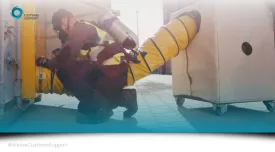Gas Analysis and Forced Ventilation in Containers
Customs Support Safety in the Netherlands is specialised in measuring and detecting gases. Our team of specialists provide extensive knowledge and experience and can also support you with unloading containers and trucks using independent breathing apparatus.
Contact us today and one of our gas analysers will be in touch.


Your Partner for Gas Analysis
The gas analysis process is essential, as when dangerous gases are found to be present, the area should be properly ventilated, and your personnel protected. At Customs Support we believe in a controlled degassing process which is carried out after conducting a comprehensive gas analysis service. Get in touch and find out how we can best support you in conducting the gas analysis.
Gas Analysis | Frequently Asked Questions - (FAQs)
How often can we be exposed to dangerous gases while unloading containers?
The occurrence of dangerous gases in shipping containers is very common. Research has shown that about 10-20% of containers have concentrations of gases that exceed occupational hygiene limit values. In other words, anyone who enters a shipping container is facing a real risk of exposure to danger.
Why can dangerous gases escape from cargo?
There are various causes. For example, gases used in production, pest control gases, or sterilisation gases. These gases may have remained behind, in or between the cargo and may have evaporated or escaped during transport, thereby creating a situation in the container or lorry that is unhealthy and dangerous for your people. In case of a suspicion of the presence of dangerous gases, it is important to have a broad and accurate investigation carried out.
How are you performing the gas analysis?
With our advanced FTIR analysis, we can accurately and substance-specifically measure hundreds of potential risk substances within a few minutes. FTIR gas analysers identify, and measure gases based on a so-called absorption pattern of infrared light that is unique for each substance. This method rules out false positive measurements. Based on the outcome of this process, containers or other spaces no longer need to be ventilated unnecessarily.
Where can you perform the gas measurements?
We carry out measurements on location at clients’ sites and various inland terminals. In addition, we have a drive-in measuring station in Rotterdam, The Netherlands where lorries can drop by for a measurement.
When should I perform the gas measurement and the degassing process?
From a logistical point of view, it is interesting to carry out gas measurements and degassing immediately on entering the port. From a safety point of view, before unloading the container, planning should be done to ensure time intervals between gas measurement, degassing and unloading are as short as possible. During transport from the port to the destination, gas can still escape from the cargo.
What is the process after completing degassing?
A container that is degassed by us is ventilated until the moment it is collected at the terminal in order to be delivered to the client. We know from experience that the gas concentrations can quickly rise again after the doors have been closed. For this reason, we advise our clients to unload the containers as soon as possible after the degassing process has been completed.











